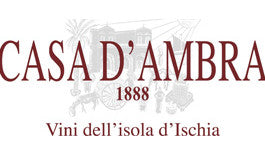Casa d'Ambra
| Region | Campania (Italia) |
|---|---|
| Foundation Year | 1888 |
| Vineyard hectares | 17 |
| Annual production | 500.000 bt |
| Address | Via Mario D'Ambra, 30 - 80075 Forio (NA) |

Casa d'Ambra, for more than a century, has represented the wine of the island of Ischia. The largest of the Phlegrean islands, dotting the marvelous panorama of the Gulf of Naples, is a land of ancient traditions. In the 8th century B.C., Greek colonists founded on the very island the first port of call of the colonization that led to the creation of Magna Graecia. With the first Hellenic settlers also came to Ischia the culture of the vine, which still today is an important resource of the local agricultural economy. Since 1888, the d'Ambra family has handed down, from generation to generation, the love for this land and for the vines. Still today it represents the most important entity on the island and produces a range of labels that allow people to appreciate the excellence of this ancient land.
Ischia's once thriving winemaking culture suffered a major downsizing in the 1960s. The development of tourism led to the gradual abandonment of the vineyard in favor of commercial activities and the loss of about two thousand hectares of vineyards to derive building land. The few remaining vineyards represent a valuable heritage to be protected and preserved. Casa d'Amba has always been committed to the recovery and restoration of the island's historic vineyards, with the aim of carrying on the ancient traditions. The vineyards are situated on terraces and steep slopes with wonderful views of the sea, rising from the coast to almost 1,000 meters. This is difficult and strenuous viticulture, requiring manual work and harvesting in impervious areas.
The volcanic origins of the island have bequeathed soils of tuffs and lava rocks rich in minerals, very suitable for viticulture. The climate is Mediterranean, with hot, dry summers mitigated only by sea breezes. Casa d'Ambra runs a cooperative of more than one hundred small Ischian growers, who cultivate their small properties directly and then deliver the grapes to the winery. In full respect of the area's ancient history, local varieties are grown on the island: Biancolella, Forastera, Falangnina, Uvarilla Greco, Malvasia di Candia and Trebbiano for whites; Piedirosso and Guarnaccia for reds. In 1995, the winery also created an experimental field for the recovery of ancient grape varieties that had almost disappeared such as: Guarnaccello, Coda Cavallo, Streppa rossa, Rillottola, the Don Lunardo, Catalanesca, Uva romana, Uva procidana, and Uva coglionara.